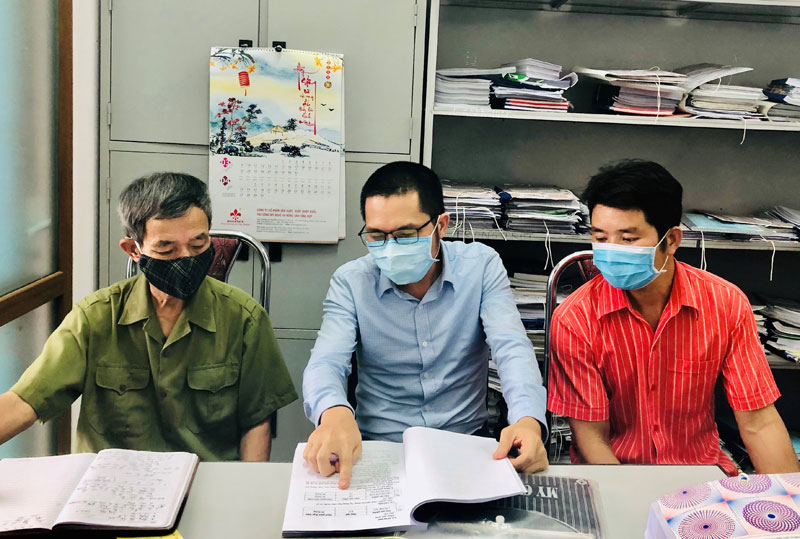
(HBO) - Authorities of Lac Thuy district in Hoa Binh province are preparing the best conditions for its nine products to make breakthroughs in the One Commune One Product (OCOP) programme this year.
Two products of the district were certified to
meet the standards of the OCOP programme in 2019.Fresh whole chicken of
Lac Thuy chicken breeding cooperative in An Binh commune received a four-star
rating, while an orange variety using chicken eggs as fertiliser grown by
farmer Vu Duy Tan in Thong Nhat commune was rated three-star.
OCOP products are
hoped to enhance competitiveness in the market, becoming a driving force for
the district’s agriculture and rural development.
 An adviser(centre) provides guidance for
product owners on the preparation of dossiers submitted to the OCOP programme
of the province.
An adviser(centre) provides guidance for
product owners on the preparation of dossiers submitted to the OCOP programme
of the province.
The People’s Committee of Lac Thuy district
has disseminated the programme's implementation plan this year to all communes
and townships so that they can select prominent products.
Therefore, the
district has the largest number of products vying for the province’s OCOP
programme. Nine local products seeking for the recognition this year include
Boi River’s tea of Boi River Thang Long Ltd. Co. in Phu Nghia commune and two
orange varieties of Chung Huong and Lan Thu farms in Phu Thanh and Phu Nghia
communes.
The others are a melon variety cultivated in Ba Hang Doi town, along with Khoan
Du honey, Lac Thuy custard apple, goat meat in Dong Tam commune, woven rattan
and lemongrass essential oil produced by An Lac Hoa eco-tourism company in An
Binh commune.
Deputy chiefof Lac Thuy district’s
Agriculture and Rural Development Division Hoang Dinh Chinh said that the
People’s Committees of both Hoa Binh province and Lac Thuy district have
earmarked funds for product owners. As many as 600 million VND (25,680 USD) was
sourced from the Hoa Binh Provincial People Committee, of which half will be
for training courses while the rest will be used to support product owners in
building dossiers.
This year, the
district plans to organize five training courses for product owners,
authorities and leaders of local organisations.
In addition, the
provincial Department of Science and Technology presented 20 million VND to
each product owner to help them make origin-tracing stamps, packaging and
labelling.
The agro-forestry-fishery product management branch will help the owners
produce their commodities under VietGAP standards with clear origins, as the
district eyes all of its OCOP products meeting the criteria./.
Hoa Binh province is undergoing a dynamic transformation amid Vietnam’s national digital transition. Building on Poliburo’s Resolution No. 57-NQ/TW on breakthroughs in science, technology, innovation, and national digital transformation, the province has rolled out a wide range of practical action plans. A standout initiative is the "Digital Literacy for All” movement, an effort to ensure that no one is left behind in the digital era.
Hoa Binh province is undergoing a dynamic transformation in the wake of the national digital transformation movement. Building on Resolution No. 57-NQ/TW of the Politburo on breakthroughs in science, technology, innovation, and national digital transformation, the province has implemented a wide range of practical action plans. A standout initiative is the "Digital Literacy for All” movement ambitious effort to ensure that no one is left behind in the digital age.
With a spirit of unity and proactive problem-solving, the Party Committee, the government and the people of Dong Lai Commune (Tan Lac District) have made great strides in implementing the resolutions of the 24th Party Congress of the commune for the 2020 - 2025 term. Focusing on leadership and practical actions, the commune has brought the Party’s resolutions into daily life, creating strong impacts and pushing the local development forward.
Amid the nationwide push for digital transformation, young people in Hoa Binh Province are stepping up as dynamic pioneers, applying technology to enhance Youth Union operations and expand the reach of youth-led initiatives. Through creativity and adaptability, Youth Union organizations at all levels have introduced a series of practical solutions, contributing to modern governance and community development.
In recent years, An Nghia commune, located in Lac Son district, has stepped up administrative reform, focusing on improving the quality and efficiency of its single-window service unit for receiving and processing administrative procedures. These improvements have helped create favourable conditions for local residents and organisations to handle administrative procedures, contributing to the commune’s broader socio-economic development.
The Prime Minister-approved master plan to develop the multi-use value of forests ecosystems through 2030, with a vision to 2050, aims to improve the management and sustainable use of forest resources, create jobs, increase incomes, and improve the living standards of ethnic minorities, people in mountainous and remote areas, forest workers and those living near forests.



 An adviser(centre) provides guidance for
product owners on the preparation of dossiers submitted to the OCOP programme
of the province.
An adviser(centre) provides guidance for
product owners on the preparation of dossiers submitted to the OCOP programme
of the province.